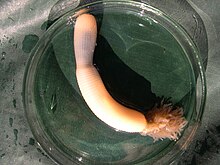Priapulus caudatus
| Priapulus caudatus | |
|---|---|

| |
| Scientific classification | |
| Domain: | Eukaryota |
| Kingdom: | Animalia |
| Phylum: | Priapulida |
| Class: | Priapulimorpha |
| Order: | Priapulimorphida |
| Family: | Priapulidae |
| Genus: | Priapulus |
| Species: | P. caudatus
|
| Binomial name | |
| Priapulus caudatus | |
| Synonyms | |
| |
Priapulus caudatus known as the cactus worm, is a marine invertebrate belonging to the phylum Priapulida.[2][3][4] It is a cylindrical, unsegmented worm which burrows in soft sediment on the seabed. It has a circumpolar distribution.
Taxonomy and evolution
Priapulus caudatus is one of only nineteen known species in the phylum
Description
A cylindrical unsegmented worm, P. caudatus grows to a length of 15 cm (6 in). The body is divided into two distinct regions; at the front is the introvert, ridged longitudinally and heavily armed with rows of spines. The mouth is at its tip and is surrounded by seven rows, each with five teeth. The introvert is retractable into the trunk, a longer and broader region with transverse, ring-like markings. It is terminated on the ventral side by a much-branched, tail-like appendage. The front of the tail is sometimes obscured by a swelling of the trunk. The whole animal is a pinkish-brown colour.[5][6]
Distribution and habitat

This species has a widespread, northerly circumpolar distribution, being present in New England, eastern Canada, Greenland, Iceland, Scotland and Scandinavia, as well as eastern Russia, Alaska and western United States, and sporadically further south. It is found in the
Ecology
Priapulus caudatus has been little studied and its ecology is poorly known.[7] It is believed to be carnivorous while other closely related species are thought to be deposit feeders and detritivores.[8] The sexes are separate and fertilisation is external. Eggs are small and yolky, and cleavage is holoblastic, radial and equal. The larvae live on the seabed and have an introvert, and a trunk enclosed by a thick cuticle into which the introvert can be retracted.[2][8]
References
- ^ a b van der Land, Jacob (2018). "Priapulus caudatus Lamarck, 1816". WoRMS. World Register of Marine Species. Retrieved 19 July 2018.
- ^ PMID 25895830.
- ^ Burgess, Dany. "The cactus worm is on point and looking sharp". Department of Ecology State of Washington.
- ^ "Priapulus caudatus Lamarck, 1816 Cactus worm". SeaLifeBase. Retrieved 15 June 2022.
- ISBN 978-94-011-5888-6.
- ^ de Kluijver, N.J. "Priapulus caudatus". Macrobenthos of the North Sea: Miscellaneous worms. Marine Species Identification Portal. Retrieved 21 July 2018.
- ^ a b Shirley, Thomas C. (1990). "Ecology of Priapulus caudatus Lamarck, 1816 (Priapulida) in an Alaskan Subarctic Ecosystem". Bulletin of Marine Science. 47 (1): 149–158.
- ^ ISBN 978-81-315-0104-7.)
{{cite book}}: CS1 maint: multiple names: authors list (link
